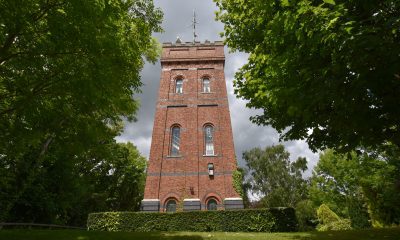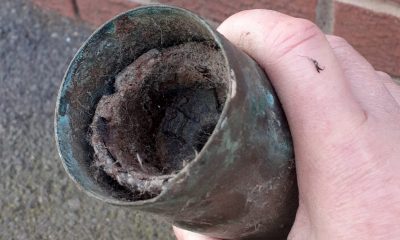Gruesome archeological find world’s best evidence of crucifixion
Published
2 years ago onBy
Talker NewsBy Ben Turner via SWNS
Archaeologists have uncovered what they claim is the "world's best evidence of crucifixion" after finding a Roman slave's heel bone embedded with a nail.
Experts say it is the clearest physical example of the Roman-era capital punishment practice to ever emerge.
A skeleton - believed to be that of a slave aged 25-35 - was found during an excavation of a Roman settlement inFenstanton, England in 2017, but it has only now been fully analyzed.
The man's right heel was embedded with a 5cm iron nail and his body was buried alongside a timber structure, believed to be a bier - or wooden board - that he had been bound and nailed to.

Experts believe he was crucified on a wooden board rather than a wooden cross which is the conventional punishment written in biblical texts and this may have been a local variation.
David Ingham, project manager for the dig, said: "It's essentially the first time that we've found physical evidence for this practice of crucifixion during an archaeological excavation.
"You just don't find this. We have written evidence but we almost never find physical evidence."
David said that it beats the previous evidence found in Israel in 1968 when a heel impaled by a nail was also found - however, this find was controversial due to the body being reburied and not found intact, as in this new discovery.
Experts say that the man was from the local area and was around 5'7 tall - the average height for the time.
It is believed he was crucified on a roadside around half a mile from where he was buried and that he died between AD 130 and AD 337, according to radiocarbon dating.

His skeleton was buried in a cemetery alongside six other graves and was one of 48 sets of remains that archaeologists found in Fenstanton's five cemeteries during excavation work in 2017 and 2018.
Despite the link between crucifixion and Christianity, experts believe there was no religious element in this case. Crucifixion was the main form of capital punishment in Roman times until Constantine the Great is believed to have banned the practice during his reign in AD 306-337.
No other nails were found in the man's body, suggesting that he was tied to the oak frame by rope and the heel bone nail was to "stop him wriggling" rather than to support his weight.
Corinne Duhig, an archaeologist at Cambridge University, examined the body and established crucifixion as the only likely explanation.
She found signs of punitive injuries and immobilization before and around the time of death, suggesting the victim may have been a slave.
The man suffered thinning around his lower legs and is believed to have been shackled at some point prior to his death.

David said the crucifixion may have been a "local variation on a theme" to the "textbook" example, such as that of Jesus in the Bible.
David said: "Crucifixion was relatively common in Roman times for criminals or people who had fallen out of favor.
"You can look up the textbook example of how Romans were meant to be crucified but, in practice, people took their own approach. It must have been a local variation on the theme.
"The nail was 51.5mm. That was with the top of the nail broken off. It was probably 7 or 8 cm originally, Whereas in the history books you would expect twice that."
The first skeletal evidence for crucifixion was found in 1968 during an excavation of a cemetery in Giv’at ha-Mivtar, just outside of Jerusalem, Israel when a heel bone with an embedded nail was discovered.
But the man's bones were moved into an ossuary - a family bone box - shortly after his death, meaning the skeleton was not found fully intact.
Other skeletons with holes in their heels were discovered in Gavello, near Venice in Italy during an infrastructure project in 2006-2007, and in Tell El-Ruba in Egypt in the 1990s, though it is not certain that either victim was crucified.
David said that the new finding offers the world's clearest evidence of crucifixion as the man's skeleton was fully intact and still had a nail embedded through the heel.
He added that the man's roadside crucifixion would have lasted more than a day and was intended to be public as a deterrent to others.
David said: "If you were nailed to a cross you would be up there for a day or more. It was meant to be visible. It was a punishment and deterrent to others.
"Officially you die from suffocation with the arms being pinned up you can't get enough air into the lungs.
"Most would be put into a pit or left out somewhere, we almost never find them buried."
Oak samples were found on the nail embedded in the man's heel bone, suggesting that he was nailed to an oak board.
The Fenstanton settlement covered around six hectares was akin to a village and was home to a cattle bone processing site.
Experts also found a 1cm-deep hole besides where the nail was embedded in the man's heel, suggesting that an initial attempt to nail his body to the wood may have failed.
Other discoveries at the Fenstanton settlement include 239 cattle bones that had been split by expert butchers and soap made from the fats of cattle bones.
The Fenstanton village was located on a Roman road between Cambridgeshire's two major settlements at the time of Cambridge and Godmanchester.
The site was excavated ahead of contractors building a new housing development.
Stories and infographics by ‘Talker Research’ are available to download & ready to use. Stories and videos by ‘Talker News’ are managed by SWNS. To license content for editorial or commercial use and to see the full scope of SWNS content, please email [email protected] or submit an inquiry via our contact form.
You may like


Couple stunned to find extremely rare pink grasshopper


Paramedics laughing hysterically as they try to explain their job goes viral


Take a look at this home inside a 90-FOOT water tower


Groom-to-be drops $1,200 engagement ring into lake during proposal


Charity workers help save 6 caged bears from squalid private zoo


6-year-old golf prodigy hopes to follow in the footsteps of his PGA-pro dad
Other Stories


New breakthrough treatment boosts cancer-fighting cells
The approach involves activating the immune cells in the body and "reprogramming" them to attack and destroy the cancer cells.


One-year-old can’t stop laughing during first ride at Disneyland
"We didn't expect him to love it that much."


Dad running marathon wearing chainmail weighing over 40 pounds
A dad is attempting to break the world record for the fastest marathon while wearing chainmail.


Hero saves elderly couple by dragging them out of burning car
The Good Samaritan jumped into action after spotting the fire on his way to work.


Bomb squad seals off town after ammunition shell donated to charity shop
Staff discovered the device in a bag of donations.
Top Talkers

 Parenting1 day ago
Parenting1 day agoSingle mom details struggles of feeding her 12 kids

 Broadcast3 days ago
Broadcast3 days agoOver 40% of Americans have no clue what a 401k is

 Broadcast1 week ago
Broadcast1 week agoGrocery shopping hungry is costing Americans this much

 Funny1 week ago
Funny1 week agoCops confused by crow mimicking police siren

 Broadcast2 days ago
Broadcast2 days agoHow hard is it for Americans to live sustainably?

 Shopping1 week ago
Shopping1 week agoGrocery shopping hungry costs Americans this much every trip

 Money3 days ago
Money3 days agoOver 40% of Americans have no clue what a 401k is

 Parenting1 week ago
Parenting1 week agoIt takes this many minutes for the average American kid to get bored

